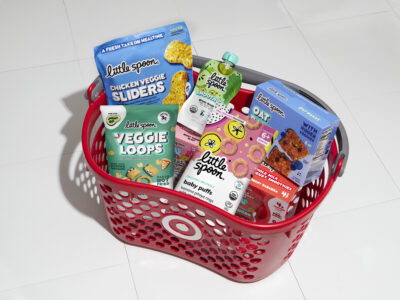Feeding babies and toddlers can be one of the most stress-inducing parts of parenthood. What should I feed my baby? Why won’t they eat vegetables? Ugh, they threw the broccoli on the floor…AGAIN. I’ve been there; I know the struggle.
First and foremost, let me take some of that feeding pressure off of you. We as parents or caregivers are responsible for what food we offer, when it is offered, and where. Our babies and children are responsible for deciding how much of the food offered they eat. That’s the long and short of it! You can only control so much.
Once we take the center of attention off of getting our kids to eat a variety of foods and instead shift it to serving a diverse assortment of foods, we can start to get creative. Now we aren’t getting our kids to do anything; we are offering them opportunities to learn to like new foods through each and every food exposure.
Studies show that the best way to encourage acceptance of new foods is to offer them early and often. The old adage “food before one is just for fun” is simply not true—we have those 6+ months to start exposing our kids to a variety of foods and begin to shape their preferences. But don’t despair if your baby is still spitting out cauliflower after the fourth try. Did you know that it can take 10-15 exposures to a food for a child to accept it? For some children, especially our more opinionated toddler-aged children, that number can go up past 20+ exposures. This is why I urge parents not to give up after the fifth or sixth time (or even sixteenth time) their child throws a tomato on the floor. I know it may sound exhausting, but you’ll be better off in the long run.
Think about it: how long did it take you, as an adult, to learn to like a food that you may not have enjoyed as a younger person? At that point you had probably already seen it dozens of times. Thus, we should give our kids ample opportunities to learn to like a food that they are quite literally meeting for the first (or second, or twentieth) time. The key is repeated exposure to a variety of foods.
So what counts as a food exposure? Here are some examples.
- One sliver of hemp seed-rolled avocado that baby grabs and drops.
- One bite of cheese on your toddler’s plate that gets licked.
- A quartered cherry tomato that gets moved from one spot to another on the tray.
- One broccoli floret on the tray that goes untouched.
- A teaspoon of beans that gets squished between baby’s fingers.
- A spoonful of pureé that was eaten yesterday but ignored today.
That’s right: even if the food doesn’t get tasted, it still counts as a food exposure. And there’s more good news! There is a whole world of opportunities to expose our kids to foods indirectly. I personally find that the indirect food exposures are just as important as the direct attempts to serve the food itself.
Introduce your little one to food away from the table—talk about different kinds of foods, make up a song about the food your tot just won’t try, grab some food stickers and name them as you stick them on your shirts, or get some play food and encourage imaginative play with (kid safe) plates and utensils. Toddlers may even try to feed their dolls and stuffed animals foods that they themselves have not eaten yet. Guess what? That’s also an indirect food exposure that will increase the likelihood of trying and liking that food.
If your child is old enough, get them involved in the kitchen! Yes, this will be messy, but it will be worth it in the long run. Seeing, touching, and being involved in the preparation of their own meals will also go a long way. The very first time my daughter ate avocado—after a year of staunch refusal—was after she carried it home from the grocery store and helped me peel it. True story!
My hope is that, armed with this knowledge, you will feel more empowered and less stressed at mealtimes…and the next time your child ignores that piece of eggplant, you will shrug it off and try again.



